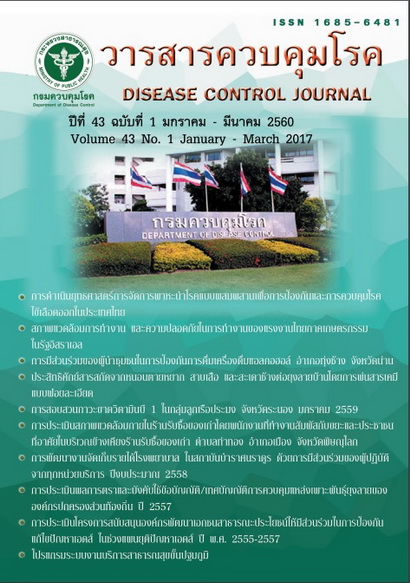Efficacy of Stemona curtisii Hook. f., Eupatorium odoratum L. and Azadirachta excelsa (Jack) Jacobs. extracts against Aedes aegypti (L.) by ultra-low volume (ULV) space spray
DOI:
https://doi.org/10.14456/dcj.2017.34Keywords:
Stemona curtisii Hook, Eupatorium odoratum L, Azadirachta excelsa (Jack) Jacobs, Extracts, Aedes aegypti (L.)Abstract
The vector borne diseases is a serious problem for worldwide health including Thailand. Several patients of Dengue Hemorrhagic Fever transmitted by Aedes aegypti (L.) have been widely reported in every year. The main strategy of this disease emphasized to control the vectors using insecticides which are the popular ways so far. However, the insecticides resistances of mosquitoes’ larvae and adults in both inside and outside countries have been recorded. To reduce chemical used, this research aimed to determine the efficacy and to find the optimal concentration of Stemona curtisii Hook. f., Eupatorium odoratum L. and Azadirachta excelsa (Jack) Jacobs. extracts obtained from maceration method on mortality of the adult Aedes aegypti (L.) using the ultra-low volume (ULV) space spray. The 2-5 day-aged laboratory strains of adult females were tested. The mortality rates from the different concentrations (0 (Control), 1, 5, 10, 20 and 50% (v/v)) were trailed and recorded the number of death mosquitoes after 24 hours exposed. It was found that no death of mosquitoes from S. curtisii Hook. f. and E. odoratum L. extracts in each concentration and A. excelsa (Jack) Jacobs. 1% extract were observed. Whereas, the mortality rates of A. excelsa (Jack) Jacobs. extracts at 5, 10, 20 and 50% were 2, 11, 78 and 100%, respectively. Based upon comparisons the mortality rates among these plant extracts, there was statistically significance at high level (p<0.01). In addition, A. excelsa (Jack) Jacobs. extract 50% exhibited as the most killing mosquitoes. The use of A. excelsa (Jack) Jacobs. extract which has natural chemistry for controlling Aedes aegypti (L.), is safer than the synthetic chemicals used. Therefore, the suitable formula for further application should be developed. It is expected that trending of herbal plants’ uses for vector control of this country would be essential in the future. Nonetheless, proper and correct choosing any herbal plants as insecticides could be considered carefully. Besides, the reliable aca¬demic and scientific researches to support in each local wisdom should be contemplated.
References
2. สำนักโรคติดต่อนำโดยแมลง กรมควบคุมโรค กระทรวงสาธารณสุข. คู่มือวิชาการโรคติดเชื้อเดงกี่และโรคไข้เลือกออกเดงกี่ด้านการแพทย์และสาธารณสุข ปี พ.ศ. 2558. กรุงเทพมหานคร: สหกรณ์การเกษตรแห่งประเทศไทย; 2559
3. บุญเสริม อ่วมอ่อง, สงคราม งามปฐม, มาโนช ศรีแก้ว. การศึกษาความไวของยุงลาย Aedes aegypti ต่อสารกำจัดแมลงในภาคกลางของประเทศไทย. วารสารวิชาการสาธารณสุข 2542;18:93-101.
4. Braga IA, Lima JBP, Soares SS, Valle D. Aedes aegyptei resistance to temephos during 2001 in several municipalities in the states of Rio de Ja¬neiro, Sergipe, and Alagoas, Brazil. Mem Inst Oswaldo Cruz [Internet]. 2004 [cited 2005 Sep 11];99:199-203. Available from: http://www. ncbi. nlm. nih.gov/pubmed/15250476
5. Macoris MLG, Maria M, Andrighetti T, Takaku L, Glasser CM, Garbeloto VC, et al. Resistance of Aedes aegypti from the State of Sao Paulo, Brazil, to Organophosphates Insecticides. Mem Inst Oswaldo Cruz 2003;98:703-8.
6. Saelim V, Roijanapremsuk J, Suvannadabba S, Pandii W, Jones JW, Sithiprasasna R. bottle and biochemical assays on temephos resistance in Aedes aegypti in Thailand [Internet]. [cited 2017 Feb 18]. Available from: www.tm.mahidol.ac. th/seameo/2005_36_2/19-3467.pdf
7. Wirth MC, Ceorghiou CP. Selection and charac¬terization of temephos resistance in a population of Aedes aegypti from Tortola, British Virgin Is¬lands. J Am Mosq Control Assoc 1999;15:315- 20.
8. ประคอง พันธุ์อุไร. รายงานการศึกษาชีววิเคราะห์ของรากหนอนตายอยาก. วารสารกรมวิทยาศาสตร์การแพทย์ 2520;19:145-55.
9. ฟรินน์ดอทคอม. หนอนตายหยาก สรรพคุณประโยชน์ของต้นหนอนตายหยาก 29 ข้อ ! [อินเทอร์เน็ต]. [สืบค้นเมื่อ 22 ส.ค. 2557]. แหล่งข้อมูล: http:// medthai.com/หนอนตายหยาก/
10. Albuquerque MRJR, Silveira ER, Uchoa DEA, Lemos TLG, Souza EB, Santiago GMP, et al. Chemical composition and larvicidal activity of the essential oils from Eupatorium betonicae¬forme (D.C.) Baker (Asteraceae). Journal of agricultural and food chemistry 2004;52:6708-11.
11. ฝ่ายชีววิทยาและนิเวศวิทยา กลุ่มกีฏวิทยาทางการแพทย์ สถาบันวิจัยวิทยาศาสตร์สาธารณสุข กรมวิทยาศาสตร์การแพทย์ กระทรวงสาธารณสุข. สมุนไพรป้องกันกำจัดแมลงทางการแพทย์. กรุงเทพมหานคร: ดีไซร์; 2546.
12. Su T, Mulla MS. Oviposition bioassay responses of Culex tarsalis and Culex quinquefasciatus. Entomologia experimentalis et applicata 1999; 91:337.
13. Awad OM, Shimaila A. Operational use of neem oil as alternative anopheline larvicide. Part A: laboratory and field efficacy. Eastern Mediterra¬7. Wirth MC, Ceorghiou CP. Selection and charac¬terization of temephos resistance in a population of Aedes aegypti from Tortola, British Virgin Is¬lands. J Am Mosq Control Assoc 1999;15:315- 20.
8. ประคอง พันธุ์อุไร. รายงานการศึกษาชีววิเคราะห์ของรากหนอนตายอยาก. วารสารกรมวิทยาศาสตร์การแพทย์ 2520;19:145-55.
9. ฟรินน์ดอทคอม. หนอนตายหยาก สรรพคุณประโยชน์ของต้นหนอนตายหยาก 29 ข้อ ! [อินเทอร์เน็ต]. [สืบค้นเมื่อ 22 ส.ค. 2557]. แหล่งข้อมูล: http:// medthai.com/หนอนตายหยาก/
10. Albuquerque MRJR, Silveira ER, Uchoa DEA, Lemos TLG, Souza EB, Santiago GMP, et al. Chemical composition and larvicidal activity of the essential oils from Eupatorium betonicae¬forme (D.C.) Baker (Asteraceae). Journal of agricultural and food chemistry 2004;52:6708-11.
11. ฝ่ายชีววิทยาและนิเวศวิทยา กลุ่มกีฏวิทยาทางการแพทย์ สถาบันวิจัยวิทยาศาสตร์สาธารณสุข กรมวิทยาศาสตร์การแพทย์ กระทรวงสาธารณสุข. สมุนไพรป้องกันกำจัดแมลงทางการแพทย์. กรุงเทพมหานคร: ดีไซร์; 2546.
12. Su T, Mulla MS. Oviposition bioassay responses of Culex tarsalis and Culex quinquefasciatus. Entomologia experimentalis et applicata 1999; 91:337.
13. Awad OM, Shimaila A. Operational use of neem oil as alternative anopheline larvicide. Part A: laboratory and field efficacy. Eastern Mediterra¬nean Health Journal 2003;9:637-45.
14. กองควบคุมวัตถุมีพิษ สำนักงานคณะกรรมการอาหารและยา. คู่มือการขึ้นทะเบียนวัตถุอันตรายที่ใช้ในบ้านเรือนหรือทางสาธารณสุข. กรุงเทพมหานคร: ชุมนุมสหกรณ์การเกษตรแห่งประเทศไทย ; 2540.
15. คณิต ขอพลอยกลาง, จารุยา ขอพลอยกลาง. ผลของสารสกัดจากสภาพแห้งของเมล็ดสะเดา (Aza¬dirachta sp.) เมล็ดน้อยหน่า (Annona sp.) รากหนอนตายหยาก (Stemona sp.) และรากหางไหล (Derris sp.) ต่ออัตราการตายของหนอนแมลงวัน แมลงวัน ลูกน้ำยุง ยุงและเห็บโค. วารสารวิจัยมหาวิทยาลัยเทคโนโลยีราชมงคลศรีวิชัย 2557;6: 39-47.
16. ณุฉัตรา วัลลีย์ลักษณ์. ผลของสารสกัดหนอนตายหยาก (Stemona collinsae) ต่อสัตว์น้ำบางชนิด. กรุงเทพมหานคร: มหาวิทยาลัยเกษตรศาสตร์ บัณฑิตวิทยาลัย; 2528.
17. มนัสวี พัฒนกุล, สนั่น ศุภธีรสกุล, สุนทร พิพิธแสงจันทร์. ประสิทธิภาพของสารสกัดจากเมล็ดสะเดาช้าง (Azadirachta excels (Jack) Jacobs.) ในการป้องกันการดูดเลือดของยุงลาย (Aedes aegypti L.). วารสารมหาวิทยาลัยทักษิณ 2551;11:35-43.
18. มัสรินทร์ นาคสุวรรณ, อรัญ งามผ่องใส, สนั่น ศุภธีรสกุล, ธีรพล ศรีชนะ. ผลของน้ำมันสะเดาช้าง และน้ำมันหมอระเหยบางชนิดต่อการตายและการพัฒนาของลูกน้ำยุงลายบ้าน. วารสารวิทยาศาสตร์เกษตร 2555;43:53-6.
19. พาลาภ สิงหเสนี. พิษของยาฆ่าแมลงต่อผู้ใช้และสิ่งแวดล้อม. พิมพ์ครั้งที่ 3. กรุงเทพมหานคร: จุฬาลงกรณ์มหาวิทยาลัย; 2535.
Downloads
Published
How to Cite
Issue
Section
License
Articles published in the Disease Control Journal are considered as academic work, research or analysis of the personal opinion of the authors, not the opinion of the Thailand Department of Disease Control or editorial team. The authors must be responsible for their articles.



.png)



